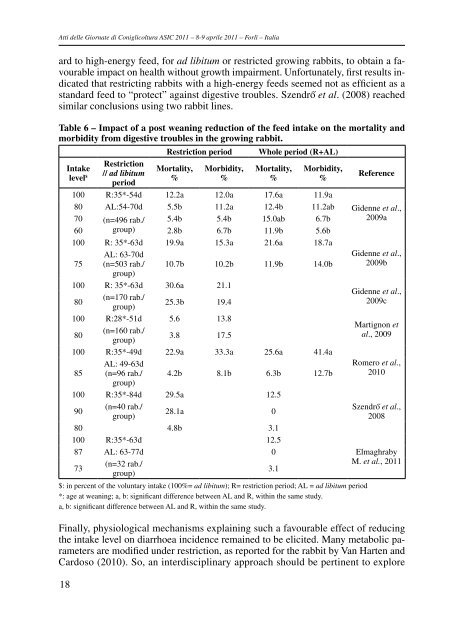atti delle giornate di coniglicoltura asic 2011 - Fondazione iniziative ...
atti delle giornate di coniglicoltura asic 2011 - Fondazione iniziative ...
atti delle giornate di coniglicoltura asic 2011 - Fondazione iniziative ...
Create successful ePaper yourself
Turn your PDF publications into a flip-book with our unique Google optimized e-Paper software.
Atti <strong>delle</strong> Giornate <strong>di</strong> Coniglicoltura AsIC <strong>2011</strong> – 8-9 aprile <strong>2011</strong> – Forlì – Italia<br />
ard to high-energy feed, for ad libitum or restricted growing rabbits, to obtain a favourable<br />
impact on health without growth impairment. unfortunately, first results in<strong>di</strong>cated<br />
that restricting rabbits with a high-energy feeds seemed not as efficient as a<br />
standard feed to “protect” against <strong>di</strong>gestive troubles. szendró´ et al. (2008) reached<br />
similar conclusions using two rabbit lines.<br />
Table 6 – Impact of a post weaning reduction of the feed intake on the mortality and<br />
morbi<strong>di</strong>ty from <strong>di</strong>gestive troubles in the growing rabbit.<br />
Restriction period whole period (R+AL)<br />
18<br />
Intake<br />
level $<br />
Restriction<br />
// ad libitum<br />
period<br />
mortality,<br />
%<br />
morbi<strong>di</strong>ty,<br />
%<br />
mortality,<br />
%<br />
morbi<strong>di</strong>ty,<br />
%<br />
100 r:35*-54d 12.2a 12.0a 17.6a 11.9a<br />
80 aL:54-70d 5.5b 11.2a 12.4b 11.2ab<br />
70 (n=496 rab./ 5.4b 5.4b 15.0ab 6.7b<br />
60 group) 2.8b 6.7b 11.9b 5.6b<br />
100 r: 35*-63d<br />
aL: 63-70d<br />
19.9a 15.3a 21.6a 18.7a<br />
75 (n=503 rab./<br />
group)<br />
10.7b 10.2b 11.9b 14.0b<br />
100 r: 35*-63d 30.6a 21.1<br />
80<br />
(n=170 rab./<br />
group)<br />
25.3b 19.4<br />
100 r:28*-51d 5.6 13.8<br />
80<br />
(n=160 rab./<br />
group)<br />
3.8 17.5<br />
100 r:35*-49d<br />
aL: 49-63d<br />
22.9a 33.3a 25.6a 41.4a<br />
85 (n=96 rab./<br />
group)<br />
4.2b 8.1b 6.3b 12.7b<br />
100 r:35*-84d 29.5a 12.5<br />
90<br />
(n=40 rab./<br />
group)<br />
28.1a 0<br />
80 4.8b 3.1<br />
100 r:35*-63d 12.5<br />
87 aL: 63-77d 0<br />
73<br />
(n=32 rab./<br />
group)<br />
3.1<br />
$: in percent of the voluntary intake (100%= ad libitum); r= restriction period; aL = ad libitum period<br />
*: age at weaning; a, b: significant <strong>di</strong>fference between aL and r, within the same study.<br />
a, b: significant <strong>di</strong>fference between aL and r, within the same study.<br />
Reference<br />
Gidenne et al.,<br />
2009a<br />
Gidenne et al.,<br />
2009b<br />
Gidenne et al.,<br />
2009c<br />
martignon et<br />
al., 2009<br />
romero et al.,<br />
2010<br />
szendró´ et al.,<br />
2008<br />
elmaghraby<br />
m. et al., <strong>2011</strong><br />
Finally, physiological mechanisms explaining such a favourable effect of reducing<br />
the intake level on <strong>di</strong>arrhoea incidence remained to be elicited. many metabolic parameters<br />
are mo<strong>di</strong>fied under restriction, as reported for the rabbit by Van harten and<br />
Cardoso (2010). so, an inter<strong>di</strong>sciplinary approach should be pertinent to explore









